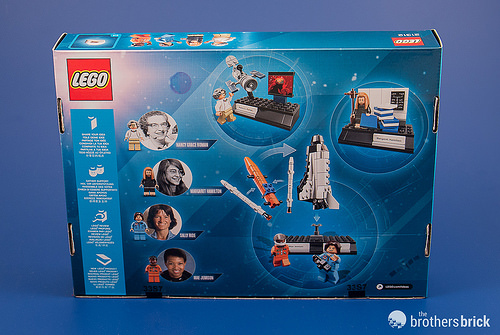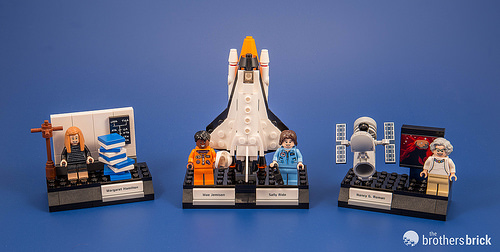LEGO recently unveiled its latest LEGO Ideas set, 21312 Women of Nasa. The set includes four minifigures depicting women astronauts, scientists, and engineers from throughout the US space program’s history. LEGO sent The Brothers Brick an early review copy of the set, which is due out on November 1st.
While the minifigures are certainly the heroes of the set, the set also includes three mini-builds, with 231 pieces. When released, the set will retail for $24.99. Given the science-oriented, minifig-centric nature of both LEGO Ideas sets, comparisons to 21110 Research Institute will be inevitable among LEGO fans, and we’ll do our best to compare and contrast them along the way.
The box and instructions
21312 Women of Nasa returns to the traditional LEGO Ideas packaging that 21310 Old Fishing Store did not use — a sturdy box that can safely store the mini-models, minifigs, and their stands after you’ve built them.
The back of the box shows the real-life women with their minifigure counterparts.
The parts for all three mini-models come in three unnumbered bags. Despite the lack of numbered bags, I was able to comfortably build each part of the set with all the parts dumped back into the box, though a younger builder might get frustrated fishing around in the black box for the right black piece.
21312 is a slightly larger set than 21110, so the box is correspondingly larger.
The instruction booklet includes several pages of biographical information about the four scientists and engineers, as well as information about fan designer Maia Weinstock and the team of LEGO set designers who turned Maia’s idea into an official LEGO set.
The build & mini-models
Each of the mini-builds serves as a stand for one or more of the minifigures. The first backdrop creates a small scene for computer scientist Margaret Hamilton, whose software was used in the Apollo, Skylab, and Space Shuttle programs. The stand uses some surprisingly elegant techniques for what amounts to a small backdrop — the whiteboard attaches vertically with clips.
The nameplate attaches to brackets on a light gray 3×4 collectible minifigure stand built into the base. This creates a sturdy attachment that might detach more easily if it were built with the more-obvious solution using a 1×4 tile under the nameplate.
The second mini-model is a rather nice Space Shuttle, complete with Solid Rocket Boosters and External Tank.
The Shuttle is the latest in a long line of LEGO Space Shuttles, including several mini-models like this one, and it serves as the stand for astronauts Mae Jemison (the first woman of color in space) and Sally Ride (the first American woman in space). However, this is the first Space Shuttle mini-model that includes the boosters and fuel tank.
Nevertheless, I have to quibble with the color choice for the External Tank, which LEGO has produced at larger scales several times. On sets like 10231/10213 and even the LEGO City 60080 Spaceport, the color of the External Tank is dark orange. It’s a deeply nerdy, nit-picky quibble, to be sure, but I don’t think the bright orange works nearly as well as dark orange would have.
The third and final stand is for astronomer Nancy G. Roman, who was instrumental in planning and designing the Hubble Space Telescope. Naturally, the stand features a mini-model of Hubble.
The backdrop also includes a printed panel with an image of the Cone Nebula captured in 2002 by Hubble. It’s a fantastic printed piece that would look right at home on a spaceship’s bridge. Hubble itself also includes two 1×4 tiles printed with a solar panel pattern.
Like the Space Shuttle, the Hubble Space Telescope mini-model captures the shape of the real-life spacecraft wonderfully. The little LEGO Hubble incorporates a garbage can piece, and the aperture door attaches to one of the trash can’s handles.
The minifigures
As enjoyable as the three mini-builds may be, the main focus of this set is the four people represented by their minifigures. The set includes minifigs depicting four real-life women who’ve contributed to the American space program — astronomer Nancy Grace Roman; computer scientist Margaret Hamilton; astronaut physicist Sally Ride; and astronaut physician Mae Jemison.
Unlike Research Institute from 2014, each of the minifigures includes brand new printed elements. Nancy G. Roman wears fantastic cat eye glasses and a colorful necklace. Sally Ride and Mae Jemison both wear NASA flight suits (Dr. Ride in light blue and Dr. Jemison in orange). Margaret Hamilton wears a black knitted dress.
All of the minifigs also have double-sided heads, with alternate expressions. I like to think that the “determined” expressions (above) reflect a passion for the scientific method while the “happy” expressions (below) capture the moment of discovery or breakthrough.
A noteworthy omission is Katherine Johnson, who chose not to participate in the project, though she was included as a fifth minifigure in the original project proposal by fan designer Maia Weinstock. There could be any number of completely understandable reasons why Ms. Johnson chose not to have herself portrayed as a LEGO minifig, ranging from not wanting to be singled out among the amazing, pioneering women she worked with during her career to having no real interest in LEGO, since she’s nearly a hundred years old! But as disappointing as this role model’s omission is, speculating about her motives for not wanting to be included is just that — speculation.
Conclusions & recommendation
In many schools and for many children — myself included, growing up back in the 70’s and 80’s — LEGO plays a pivotal role in fostering a passion not just for creativity more generally but for STEM (Science, Technology, Engineering, and Math) specifically. I feel a deep debt of gratitude toward LEGO for the role it played in inspiring my twenty-year career in technology today. Perhaps caused by past decisions about the default gender for minifigs in professional roles, compounded by continued market success with boys aged 5-12, LEGO continues to have a perception as a “boy’s toy.” The company has made huge strides toward greater diversity in key themes like LEGO City — the current 60141 Police Station features an evenly split police force and even a female burglar! Nevertheless, the company still has a long way to go to level the playing field and attract girls to the toy outside the “pink aisles” with LEGO Friends.
Thus, I wholeheartedly endorse LEGO’s specific attention to the achievements of women in STEM with this LEGO Ideas set, and I hope that it will inspire more young women to choose education and careers that will lead to the next great breakthroughs for humanity. But setting aside the subject matter, this is still an excellent LEGO set on its own merits, with some great printed parts, fantastic minifigs, and fun little display models of the Shuttle and Hubble especially.
At $24.99 for 4 minifigs and 231 pieces, it’s also a pretty good deal (even better than the $20 for 165 pieces for Research Institute). We highly recommend this set, and hope that LEGO is better able to predict the demand for this set than they did for Research Institute — it deserves to get into the hands of many more people than the very limited run of that earlier set.
LEGO Ideas 21312 Women of Nasa will be available from the LEGO Shop online starting November 1st for $24.99.
The LEGO Group sent The Brothers Brick an early copy of this set for review. Providing TBB with products for review guarantees neither coverage nor positive reviews.















I can’t wait to get this set (I’m ordering it as soon as possible – checking the Lego website every day at the moment), and I’ll be sure to put it in a place where my 5 year old daughter will see it every day to the point she thinks that NASA is run by women.
Indeed, Lego has a long way to go to become a “toy” instead of a “boy toy” in people’s minds. And this is definitely a huge step in the right direction.
Making the City line more gender neutral is a must too I think. Enough with the cops and burglars, and more sets with… you know… City life stuff.
Last summer I visited my home country (France) and going to a toy store, first I was confused that I couldn’t find any Lego Friends or Elves (while I try to have my daughter play with all kinds of Lego, she still prefer Friends and Elves)… Oh I found them… On the other side of the store with the “girls toys”.
I was pretty shocked. With all the issues of sexism my host country (Japan) has, at least, Lego is usually in the gender neutral section of toy stores and I’m grateful for that.
That’s great!